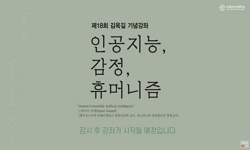This study examines the positive and negative images of artificial intelligence portrayed in the mass media focusing on television advertisements and movies, and will summarize based on the results, the prospects for human interaction with artificial ...
http://chineseinput.net/에서 pinyin(병음)방식으로 중국어를 변환할 수 있습니다.
변환된 중국어를 복사하여 사용하시면 됩니다.
- 中文 을 입력하시려면 zhongwen을 입력하시고 space를누르시면됩니다.
- 北京 을 입력하시려면 beijing을 입력하시고 space를 누르시면 됩니다.

텔레비전 광고와 영화에 표현된 인공 지능의 이미지 = The Image of Artificial Intelligence Expressed in Television Advertisements and Movies
한글로보기https://www.riss.kr/link?id=A107402601
- 저자
- 발행기관
- 학술지명
- 권호사항
-
발행연도
2021
-
작성언어
-
- 주제어
-
KDC
300
-
등재정보
KCI등재
-
자료형태
학술저널
-
수록면
1237-1252(16쪽)
-
KCI 피인용횟수
0
- 제공처
-
0
상세조회 -
0
다운로드
부가정보
다국어 초록 (Multilingual Abstract)
This study examines the positive and negative images of artificial intelligence portrayed in the mass media focusing on television advertisements and movies, and will summarize based on the results, the prospects for human interaction with artificial intelligence. Most of the artificial intelligence shown in television advertisements involve speech recognition speakers, which show how convenient our daily life can be with such speakers, and emphasize the convenience of this technology for people with disabilities. In contrast, the negative images that appear in advertisements are considered to foster gender bias, including gender interests and gender roles stereotypes. In movies, artificial intelligence is often expressed as super-artificial intelligence. While positive images reveal that behind these is an aspiration to match human abilities as much as possible and coexist human, the negative images reveal the attempt to replace humans from the Earth, or eliminate humans with technology of super-artificial intelligence that surpasses human capabilities.
참고문헌 (Reference)
1 "텔레비전 광고 인터넷 사이트"
2 신세인, "인공지능에 대한 초등학생들의 이미지 탐색" 한국초등과학교육학회 37 (37): 126-146, 2018
3 김용주, "인공지능(AI; Artificial Intelligence) 창작물에 대한 저작물로서의 보호가능성" 법학연구소 27 (27): 267-297, 2016
4 박성춘, "인공지능 영화 속에 나타난 미래 세계의 상상적 공간 특성 연구" 국민대학교 대학원 2019
5 한국소비자원, "인공지능 가전제품 문제점 및 개선방안: 음성인식 스피커를 중심으로" 한국소비자원 2017
6 황소영, "예비유아교사가 인식한 인공지능 이미지 분석" 학습자중심교과교육학회 20 (20): 1255-1283, 2020
7 안용태, "안용태의 유쾌한 인문학 블로그: 터미네이터, 오토포이에시스와 인공지능"
8 김휘택, "담론의 재현을 통해 본 인공지능 형상화에 대한 연구" 한국문화융합학회 40 (40): 175-202, 2018
9 차영란, "광고 및 미디어 산업 분야의 인공지능(AI) 활용 전략 : 심층인터뷰를 중심으로" 한국콘텐츠학회 18 (18): 102-115, 2018
10 유비, "SF 영화 속 인공지능 로봇 캐릭터 및 서사 연구: <바이센테니얼맨>과
1 "텔레비전 광고 인터넷 사이트"
2 신세인, "인공지능에 대한 초등학생들의 이미지 탐색" 한국초등과학교육학회 37 (37): 126-146, 2018
3 김용주, "인공지능(AI; Artificial Intelligence) 창작물에 대한 저작물로서의 보호가능성" 법학연구소 27 (27): 267-297, 2016
4 박성춘, "인공지능 영화 속에 나타난 미래 세계의 상상적 공간 특성 연구" 국민대학교 대학원 2019
5 한국소비자원, "인공지능 가전제품 문제점 및 개선방안: 음성인식 스피커를 중심으로" 한국소비자원 2017
6 황소영, "예비유아교사가 인식한 인공지능 이미지 분석" 학습자중심교과교육학회 20 (20): 1255-1283, 2020
7 안용태, "안용태의 유쾌한 인문학 블로그: 터미네이터, 오토포이에시스와 인공지능"
8 김휘택, "담론의 재현을 통해 본 인공지능 형상화에 대한 연구" 한국문화융합학회 40 (40): 175-202, 2018
9 차영란, "광고 및 미디어 산업 분야의 인공지능(AI) 활용 전략 : 심층인터뷰를 중심으로" 한국콘텐츠학회 18 (18): 102-115, 2018
10 유비, "SF 영화 속 인공지능 로봇 캐릭터 및 서사 연구: <바이센테니얼맨>과
11 네이버 지식백과, "IT 용어 사전"
12 Nass, C., "Are machines gender neutral?Gender-stereotypic responses to computers with voices" 27 (27): 864-876, 1997
13 이혜지, "AI 기기의 감성 교류 및 사용지속성 향상을 위한 빛 인터랙션 디자인 연구" 이화여자대학교 대학원 2019
동일학술지(권/호) 다른 논문
-
스코핑 고찰 방법을 활용한 한국 상호문화교육 연구 동향 분석
- 인문사회 21
- 강비아 ( Bia Kang )
- 2021
- KCI등재
-
- 인문사회 21
- 강수향 ( Soohyang Kang )
- 2021
- KCI등재
-
- 인문사회 21
- 이은석 ( Eunsuk Lee )
- 2021
- KCI등재
-
참여자 관점에서의 자활사업 체계화 및 활성화 방안 제언
- 인문사회 21
- 이진명 ( Jinmyong Lee )
- 2021
- KCI등재
분석정보
인용정보 인용지수 설명보기
학술지 이력
| 연월일 | 이력구분 | 이력상세 | 등재구분 |
|---|---|---|---|
| 2026 | 평가예정 | 재인증평가 신청대상 (재인증) | |
| 2020-01-01 | 평가 | 등재학술지 유지 (재인증) |  |
| 2017-01-01 | 평가 | 등재학술지 선정 (계속평가) |  |
| 2015-01-01 | 평가 | 등재후보학술지 선정 (신규평가) |  |
학술지 인용정보
| 기준연도 | WOS-KCI 통합IF(2년) | KCIF(2년) | KCIF(3년) |
|---|---|---|---|
| 2016 | 0 | 0 | 0 |
| KCIF(4년) | KCIF(5년) | 중심성지수(3년) | 즉시성지수 |
| 0 | 0 | 0 | 0.12 |
연관 공개강의(KOCW)
-

누구나 할 수 있는 데이터 분석과 인공지능[Data Analysis and Artificial Intelligence for Everyone]
K-MOOC 인하공업전문대학 이세훈 -

누구나 할 수 있는 데이터 분석과 인공지능[Data Analysis and Artificial Intelligence for Everyone]
K-MOOC 인하공업전문대학 이세훈 -

[제18회 김옥길기념강좌] 인공지능, 감정, 휴머니즘(Human-Compatible Artificial Intelligence’)’
이화여자대학교 스튜어드 러셀 -

영화속인공지능과인문학
영남대학교 신지숙 -

인공지능 만들기
K-MOOC 서울대학교 장병탁




 KCI
KCI KISS
KISS

